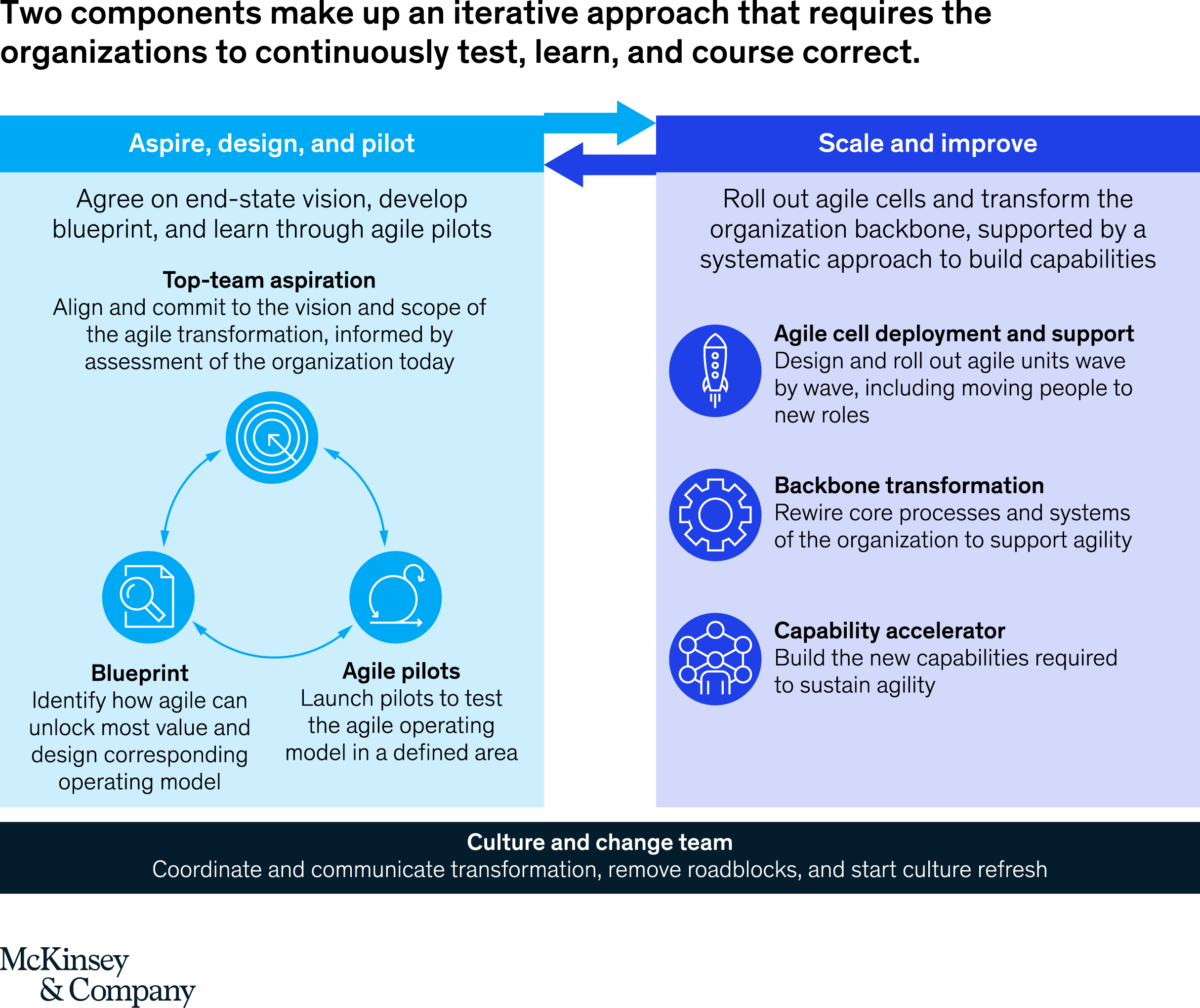agile organizations are characterized as a network of teams operating in rapid learning and decision-making cycles.
Origen: The journey to an agile organization | McKinsey
Agile organizations are different. Traditional organizations are built around a static, siloed, structural hierarchy, whereas agile organizations are characterized as a network of teams operating in rapid learning and decision-making cycles. … An agile organization can ideally combine velocity and adaptability with stability and efficiency.
Any enterprise-wide agile transformation needs to be both comprehensive and iterative. That is, it should be comprehensive in that it touches strategy, structure, people, process, and technology, and iterative in that not everything can be planned up front.
3 types of journeys to agile: All-in, which entails an organization-wide commitment to go agile and a series of waves of agile transformation; Step-wise, which involves a systematic and more discreet approach; and Emergent, which represents essentially a bottom-up approach.
Most organizations must undergo a transformation to embrace enterprise agility. Such transformations vary in pace, scope, and approach, but all contain a set of common elements across two broad stages.
1.- successful transformations start with an effort to aspire, design, and pilot the new agile operating model. These elements can occur in any order and often happen in parallel.
2.- the impetus to scale and improve involves increasing the number of agile cells. However, this involves much more than simply rolling out more pilots.
Organizations may iterate among these stages as they roll out agility across more and more of their component parts.
Aspire, design, and pilot
Most transformations start with building the top team’s understanding and aspirations, creating a blueprint to identify how agility will add value, and learning through agile pilot.
–Top-team aspiration
Adopting an agile operating model can alleviate challenges in the current organization (such as unclear accountabilities, problematic interfaces, or slow decision making). Yet a desire to address pain points is not enough; there is a bigger prize. As one CEO observed, “I’d never have launched this agile transformation if I only wanted to remove pain points; we’re doing this because we need to fundamentally transform the company to compete in the future.” This aligns with McKinsey research showing that transformations emphasising both strengths and challenges are three times more likely to succeed.
–Blueprint
The first step in blueprinting is to get clear on where the value lies.
Next comes structure.
Individual agile cells are defined by outcomes or missions rather than by input actions or capabilities.
1st cross-functional teams deliver products, projects, or activities.
2nd self-managing teams deliver baseload activity and are relatively stable over time.
3rd flow-to-work pools of individuals are staffed full time to different tasks based on the priority of the need.Working in teams may sound familiar, but at scale this requires change across the whole operating model to provide appropriate governance and coordination. Backbone elements include core processes, people elements, and technology components.
The final step of blueprinting is to outline the implementation road map.
–Agile pilots
The scope of the agile pilot must be defined and the team set up with a practical end in view; this might include deciding on team staffing, structure, workspace, facilities, and resources.
Agile scale-up first and foremost requires standing up more agile cells. … But at some point, it is necessary to leap toward the new agile operating model, ways of working, and culture. …Many chose to start by transforming their headquarters and product-development organizations before touching frontline, customer-facing units (call centers, stores, or manufacturing facilities).
The size and scope of waves depend on the context and aspiration.
The backbone governs how decisions get made; how people, budgets, and capital get deployed; and how risk gets managed. Taking an organization to an agile operating model requires that this backbone be transformed.
Accelerating capabilities
A typical capability journey may well have distinct phases.
First, organizations need to identify the number of trainers required, and then hire and develop them.
Second, the organization must define the new agile roles.
Third, learning and career paths should be set for all staff.
Fourth, the organization needs to enable continuous learning and improvement across the organization.
Finally, it’s necessary to design and run a whole-organization effort to raise agile skills.
The importance of investing in culture and change on the journey to agility cannot be overstated. Agile is, above all, a mind-set. Without the right mind-set, all other parts of the agile operating system can be in place, and yet companies will see few benefits.
Understanding transformation archetypes
All successful enterprise-wide agile transformations include the elements described above, but there are several different ways in which the elements can be combined and sequenced. As introduced earlier, there are three major transformation archetypes:
-
Step-wise. …the most common transformation archetype shows a clear distinction between the aspire, design, and pilot phase and the scale and improve phase. … It is not uncommon for this process to take one to two years, as leaders and the organization build familiarity with agility and prove to themselves that agile ways of working can bring value in their organization.
-
All-in. Leaders from these organizations define a plan to execute all steps of the transformation approach as quickly as possible. …it is more common for the transformation to proceed through a number of planned waves.
-
Emergent. It is impossible—and not very agile—to plan out an agile transformation in detail from the start. …an aspiration from top leaders sets a clear direction, and significant effort is spent building agile mind-sets and capabilities among leaders.

